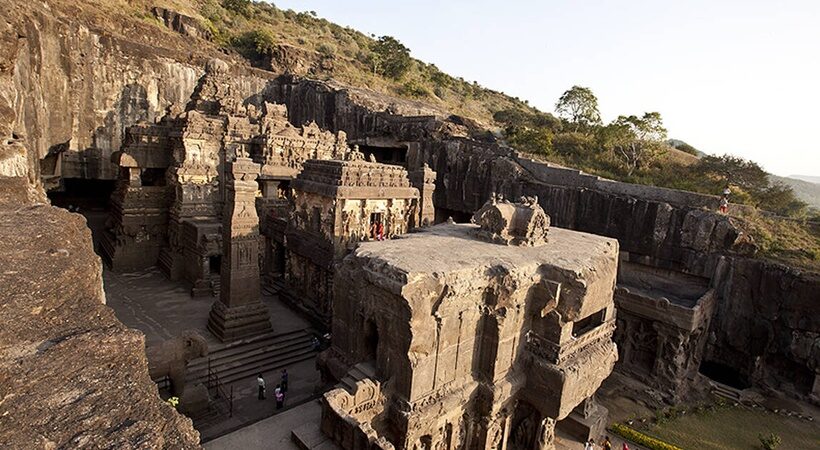Featuring the largest single monolithic rock excavation in the world, the Kailash temple, and the Ellora caves are truly a sight to behold. Recognized as a World Heritage Site by UNESCO, these are 34 monasteries and temples that extend over an area of more than 2 km. The caves were dug side by side in the wall of a high basalt cliff, not far from Aurangabad, in Maharashtra. One of the unique aspects of the cave complex is the uninterrupted sequence of monuments dating from A.D. 600 to 1000, bringing the civilization of ancient India to life.
The Ellora complex is considered to be a unique artistic creation and a technological marvel of humankind. Within the Ellora cave complex, the sanctuaries are devoted to Buddhism, Jainism and Brahmanism. This co-existence of sometimes competing religions (for patronage etc.) in a singular landscape is thought to be an expression of tolerance and the spirit of co-existence in South Asia.

The earliest caves (caves 1–12), excavated between the 5th and 8th centuries, reflect the Mahayana philosophy of Buddhism then prevalent in this region. The Brahmanical group of caves (caves 13–29), including the renowned Kailasa temple (cave 16), was excavated between the 7th and 10th centuries. The last phase, between the 9th and 12th centuries, saw the excavation of a group of caves (caves 30–34) reflecting Jain philosophy.
Amongst the caves of the Buddhist group, Cave 10, Cave 11, and Cave 12 are particularly important. These caves mark the evolution of Vajrayana Buddhism and represent a host of Buddhist deities. In the case of the Brahmanical group, the most important caves are Cave 15 (Dasavatara, or Cave of Ten Incarnations), Cave 16 (Kailasa, the largest monolithic temple), Cave 21 (Ramesvara), and Cave 29 (Dumar Lena).
The most remarkable of the cave temples is Kailasa, named after the mountain in the Kailas Range of the Himalayas where the Hindu god Shiva resides. Unlike other temples at the site, which were first delved horizontally into the rock face, the Kailasa complex was excavated downward from a basaltic slope and is therefore largely exposed to sunlight. Construction of the temple in the 8th century, beginning in the reign of Krishna I (c. 756–773), involved the removal of 150,000 to 200,000 tons of solid rock.
The complex happens to be 164 feet (50 metres) long, 108 feet (33 metres) wide, and 100 feet (30 metres) high and has four levels or stories. Containing elaborately carved monoliths and halls with stairs, doorways, windows and numerous fixed sculptures, the cave complex features some of the greatest sculptural feats in Indian art, including a scene of Vishnu getting transformed into a man-lion and battling a demon, a monument to Shiva’s bull Nandi and the life-size sculptures of elephants and other animals. One of the famous depictions in the temple includes the 10-headed demon king Ravana shaking Kailasa mountain in a show of strength.
Through their art and architecture, the Ellora Caves serve as a window to ancient India, including socio-cultural phenomena, material culture, politics and lifestyles.



















